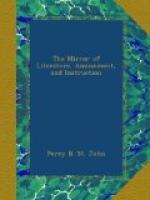* * * * *
GOOD NIGHT.
In northern Europe we may, without impropriety, say good night! to departing friends at any hour of darkness; but the Italians utter their Felicissima Notte only once. The arrival of candles marks the division between day and night, and when they are brought in, the Italians thus salute each other. How impossible it is to convey the exact properties of a foreign language by translation! Every word, from the highest to the lowest, has a peculiar significance, determinable only by an accurate knowledge of national and local attributes and peculiarites.
GOETHE.—Blackwood’s Magazine.
* * * * *
THE ANECDOTE GALLERY.
* * * * *
THE EDDYSTONE LIGHTHOUSE.
(For The Mirror.)
In the year 1696, Mr. Henry Winstanley, undertook to build the Eddystone Lighthouse, and in 1700 he completed it. So confident was this ingenious mechanic of the stability of his edifice, that he declared his wish to be in it during the most tremendous storm that could arise. This wish he unfortunately obtained, for he perished in it during the dreadful storm which destroyed it, November 27th, 1703. While he was there with his workmen and light-keepers, that dreadful storm began, which raged most violently on the night of the 26th of the month, and appears to have been one of the most tremendous ever experienced in Great Britain, for its vast and extensive devastation. The next morning, at daybreak, the hurricane increased to a degree unparalleled; and the lighthouse no longer able to sustain its fury, was swept into the bosom of the deep, with all its ill-fated inmates. When the storm abated, about the 29th, people went off to see if any thing remained, but nothing was left save a few large irons, whereby the work had been so fastened into a clink, that it could never afterwards be disengaged, till it was cut out in the year 1756. The lighthouse had not long been destroyed, before the Winchelsea, a Virginiaman, laden with tobacco, for Plymouth, was wrecked on the Eddystone rocks in the night, and every soul perished.
Smeaton, in his Narrative of the Construction of the Eddystone Lighthouse, says, “Winstanley had distinguished himself in a certain branch of mechanics, the tendency of which is to excite wonder and surprise. He had at his house at Littlebury, in Essex, a set of contrivances, such as the following:—Being taken into one particular room of his house, and there observing an old slipper carelessly lying in the middle of the floor, if, as was natural, you gave it a kick with your foot, up started a ghost before you; if you sat down in a certain chair, a couple of arms would immediately clasp you in, so as to render it impossible for you to disengage yourself till your attendant set you at liberty; and if you sat down in a certain arbour by the side of a canal, you were forthwith sent out afloat into the middle, from whence it was impossible for you to escape till the manager returned you to your former place.”




